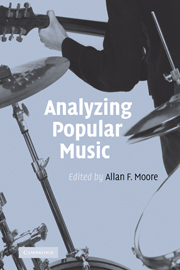Book contents
- Frontmatter
- Contents
- Acknowledgement
- Contributors
- 1 Introduction
- 2 Popular music analysis: ten apothegms and four instances
- 3 From lyric to anti-lyric: analyzing the words in pop song
- 4 The sound is ‘out there’: score, sound design and exoticism in The X-Files
- 5 Feel the beat come down: house music as rhetoric
- 6 The determining role of performance in the articulation of meaning: the case of ‘Try a Little Tenderness’
- 7 Marxist music analysis without Adorno: popular music and urban geography
- 8 Jethro Tull and the case for modernism in mass culture
- 9 Pangs of history in late 1970s new-wave rock
- 10 Is anybody listening?
- 11 Talk and text: popular music and ethnomusicology
- Bibliography
- Discography
- Film/Videography
- Index
2 - Popular music analysis: ten apothegms and four instances
Published online by Cambridge University Press: 22 September 2009
- Frontmatter
- Contents
- Acknowledgement
- Contributors
- 1 Introduction
- 2 Popular music analysis: ten apothegms and four instances
- 3 From lyric to anti-lyric: analyzing the words in pop song
- 4 The sound is ‘out there’: score, sound design and exoticism in The X-Files
- 5 Feel the beat come down: house music as rhetoric
- 6 The determining role of performance in the articulation of meaning: the case of ‘Try a Little Tenderness’
- 7 Marxist music analysis without Adorno: popular music and urban geography
- 8 Jethro Tull and the case for modernism in mass culture
- 9 Pangs of history in late 1970s new-wave rock
- 10 Is anybody listening?
- 11 Talk and text: popular music and ethnomusicology
- Bibliography
- Discography
- Film/Videography
- Index
Summary
About thirty years ago there was much talk that geologists ought only to observe and not theorize; and I well remember someone saying that at this rate a man might as well go into a gravel-pit and count the pebbles and describe the colours. How odd it is that anyone should not see that all observation must be for or against some view if it is to be of any service!
Introduction
What exactly constitutes ‘analysis’ of the texts, performances and discourses of popular music too often goes without saying. Indeed, the very idea of musical analysis has often been disparaged or defended as though it inevitably implies the deployment of ready-made models that had originally been designed to demonstrate the supremacy of German instrumental music or the underlying coherence of jarring modernisms. But basic questions of analytical method deserve to be continually rethought, since interpreting the musical texts and activities upon which pleasures and powers of popular music depend ought to constitute one of the central activities of popular music studies. And yet much of the popular music analysis that has been appearing lately simply applies methods that were developed for very different repertoires, without much explicit concern about the fit.
- Type
- Chapter
- Information
- Analyzing Popular Music , pp. 16 - 38Publisher: Cambridge University PressPrint publication year: 2003
- 26
- Cited by



